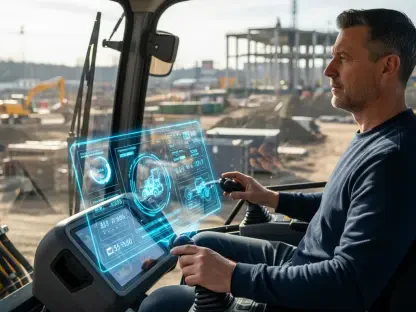In a groundbreaking move that promises to revolutionize transportation, Michigan has unveiled its first smart highway, a pioneering effort spearheaded by the Michigan Department of Transportation (MDOT) that represents a step into a future where technology and infrastructure seamlessly integrate to improve road safety and efficiency. Situated along a vital stretch of I-94 through Detroit, this initiative is positioned to transform one of the state’s busiest commuter and freight corridors by embedding advanced technologies into traditional roadways.
Advanced Technological Components
Real-Time Data Collection and Usage
One of the most critical aspects of Michigan’s smart highway is its extensive use of advanced sensors and communication systems, which are strategically placed along the highway. These devices continuously gather real-time data on traffic volume, weather, and road conditions. This data collection is crucial for drivers and traffic managers alike, enabling them to make informed decisions that can significantly enhance safety and improve the overall flow of traffic.
The real-time data also feeds into an intricate system designed to analyze patterns and predict potential issues. By relying on this information, traffic management systems can dynamically adjust traffic signals, ramp meters, and message boards to provide up-to-date information and guidance to drivers. This ensures a more responsive and adaptive roadway environment that can promptly react to changing conditions, thereby reducing the likelihood of accidents and congestion.
Vehicle-to-Infrastructure Communication
Another standout feature of the smart highway is the implementation of vehicle-to-infrastructure (V2I) communication technology. This sophisticated system allows the road to “communicate” with connected vehicles, providing essential alerts about potential hazards or changes in road conditions. This form of communication is pivotal in reducing collisions and enhancing traffic management, as drivers receive timely warnings about obstacles, road work, and other critical information.
This technology is also integral for the operation of autonomous and semi-autonomous vehicles. The smart highway supplies these vehicles with the necessary data to navigate safely and efficiently. By establishing dedicated lanes for autonomous and connected vehicles, the highway creates a controlled environment where these advanced vehicles can operate alongside traditional ones. This not only facilitates safer movement but also helps in rigorous testing and fine-tuning of automated driving technologies.
Safety and Environmental Benefits
Traffic Management and Dynamic Speed Limits
The smart highway is designed with a strong emphasis on safety and efficient traffic management. One innovative feature is the dynamic speed limits system, which adjusts the speed limits based on real-time conditions. For instance, during adverse weather conditions or traffic congestion, the system can lower speed limits to enhance safety. This adaptive approach significantly mitigates the potential for accidents caused by sudden changes in driving conditions or human error.
Moreover, the dynamic management of traffic flow helps in alleviating congestion, ensuring a smoother and quicker commute. By preventing bottlenecks and optimizing the movement of vehicles, the highway can maintain a steady traffic stream, improving the overall travel experience for drivers while also reducing the stress associated with stop-and-go traffic scenarios.
Environmental Considerations
Environmental sustainability is a key consideration in the design of the smart highway. By promoting smoother traffic flow, the highway helps reduce vehicle idling time, leading to lower emissions. This is particularly beneficial for long-haul vehicles, which are significant contributors to air pollution. The system can also recommend alternative routes to avoid traffic congestion, further decreasing fuel consumption and emissions.
Additionally, the smart highway project includes the potential utilization of renewable energy sources such as solar panels, installed alongside the roadway to power various technologies and infrastructures. This commitment to reducing carbon footprints and fostering eco-friendly practices aligns with broader environmental goals and efforts to combat climate change.
Public Involvement and Future Outlook
Community Engagement and Funding
From the outset, public involvement has been a cornerstone of the smart highway initiative. MDOT hosted multiple community meetings to gather input and build public trust and acceptance. This collaborative approach ensured that the concerns and suggestions of local residents were taken into account, leading to a more inclusive project design.
Funding for the smart highway project is a cooperative effort between the state government and private corporations, creating a shared investment in both the costs and potential benefits of this technological advancement. This partnership model not only eases the financial burden on the state but also taps into the expertise and resources of tech companies, fostering innovation and efficient project execution.
Addressing Challenges and Future Expansion
Michigan has made a groundbreaking move that is set to revolutionize transportation with the unveiling of its first smart highway. This pioneering project is driven by the Michigan Department of Transportation (MDOT) and marks a significant step towards a future where technology and infrastructure blend seamlessly to enhance road safety and efficiency. The smart highway is located along a crucial segment of I-94 through Detroit, and aims to transform one of the state’s busiest corridors for both commuters and freight. By embedding advanced technologies into traditional roadways, Michigan hopes to set a new standard in transportation. This initiative will likely improve traffic management, reduce congestion, and enhance overall safety for drivers. The endeavor reflects Michigan’s commitment to leading the way in integrating innovative technology with essential infrastructure, paving the path for smarter and safer travel. As other regions look to Michigan’s example, this effort is expected to inspire similar advancements in transportation nationwide.









